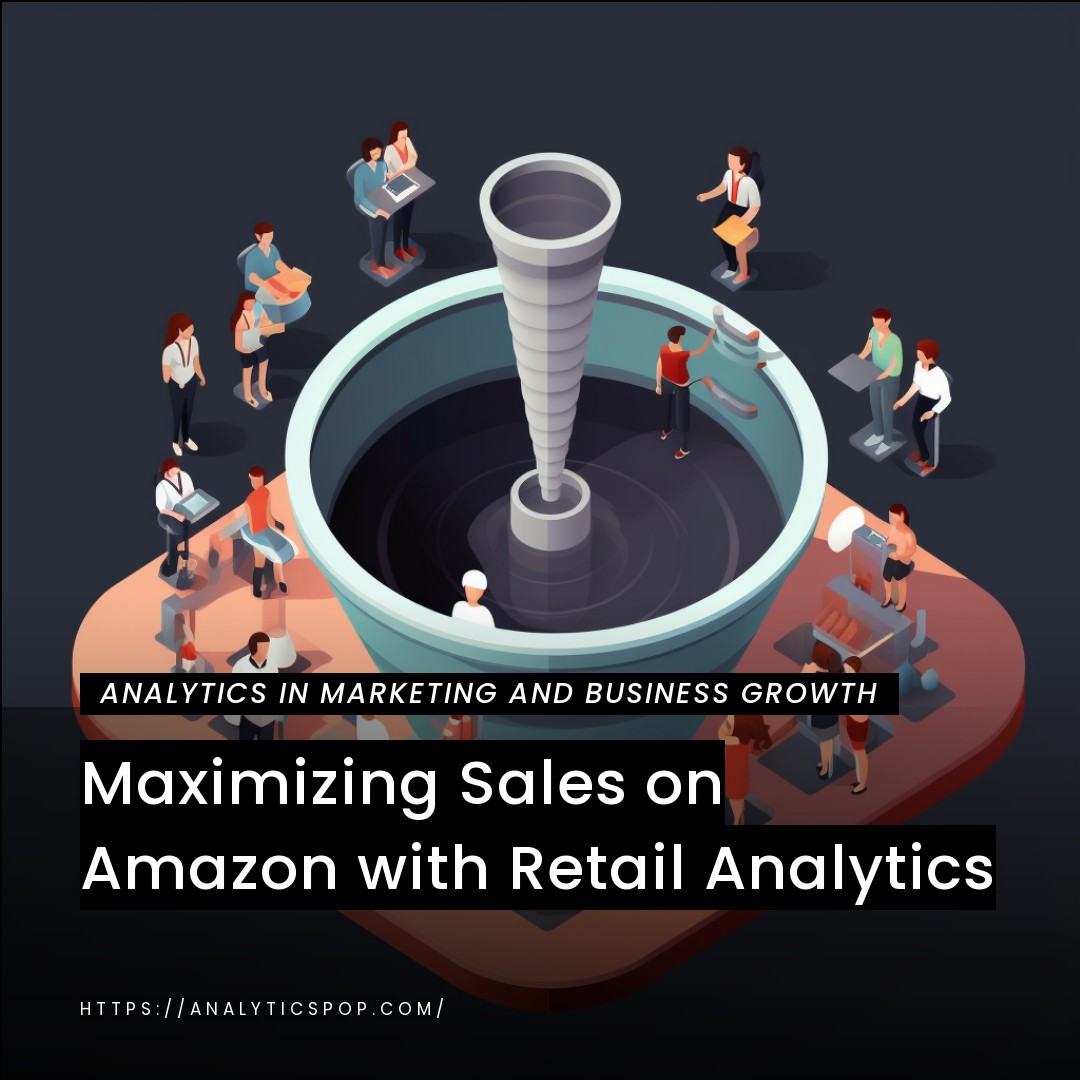Maximizing sales on Amazon is a top priority for any business selling on the platform. Retail analytics is an essential tool for achieving this goal. Businesses can identify trends and patterns to optimize their sales strategy by analyzing sales data.
- One of the best practices for success is to monitor and track key performance indicators (KPIs) regularly. These may include sales revenue, conversion rates, customer acquisition cost (CAC), and lifetime value (CLV). By tracking these metrics, businesses can identify areas for improvement and take necessary action.
- Another best practice is optimizing product listings using keywords relevant to the product and the target audience. This can help improve product visibility and search rankings, leading to increased sales.
- Additionally, offering promotions and discounts, leveraging social media to drive traffic to Amazon listings, and providing exceptional customer service can increase sales on the platform.
It is also essential to monitor competitors and their pricing strategies. Businesses can remain competitive and maximize sales by analyzing competitor data and adjusting pricing accordingly. With the help of retail analytics, companies can gain valuable insights to optimize their Amazon sales strategy and achieve success on the platform.
Why Use Retail Analytics for Amazon Sales?
Retail analytics is crucial for businesses looking to maximize their sales on Amazon. The platform is highly competitive, with millions of sellers vying for customers’ attention. Retail analytics can give companies valuable insights into their sales performance, customer behavior, and competitor activity.
One of the primary benefits of using retail analytics for Amazon sales is the ability to track key performance indicators (KPIs) and metrics. By regularly monitoring and analyzing sales data, businesses can identify areas for improvement, make data-driven decisions, and optimize their sales strategy accordingly.
Retail analytics can also help businesses identify trends and patterns in customer behavior, allowing them to tailor their marketing and sales efforts to target specific customer segments.
Retail analytics can also give businesses valuable insights into their competitors’ activity on the platform. By analyzing competitor data, companies trends, adjust its pricing strategies and remain competitive in a crowded marketplace.
Additionally, by analyzing competitor tactics, retail analysis can help businesses identify emerging trends and new product opportunities, allowing them to stay ahead of the competition.
Using retail analytics for Amazon sales can help businesses increase sales, improve customer satisfaction, and gain a competitive edge on the platform.
An overview of the benefits of using retail analytics for Amazon sales optimization
Retail analytics can provide businesses with a wide range of benefits when it comes to optimizing their sales on Amazon. Here are some of the key benefits of using retail analytics for Amazon sales optimization:
- Improved Sales Performance: By analyzing sales data, businesses can identify trends, patterns, and opportunities to improve their sales performance on Amazon. They can gain insights into which products are selling well, which are not, and what factors contribute to their success or failure.
- Better Customer Understanding: Retail analytics can help businesses better understand customer behavior, preferences, and buying habits. By analyzing customer data, companies can tailor their marketing and sales efforts to specific customer segments and provide a more personalized shopping experience.
- Competitive Advantage: Retail analytics can give businesses valuable insights into competitors’ pricing strategies, product offerings, and marketing efforts. Companies can adjust their strategy by analyzing competitor data to remain competitive in a crowded marketplace.
- Enhanced Inventory Management: Retail analytics can help businesses optimize their inventory levels and reduce the risk of overstocking or understocking. Companies can predict demand and adjust their inventory levels by analyzing sales data.
- Data-Driven Decision Making: By using retail analytics, businesses can make data-driven decisions based on real-time, accurate data. This can help them make more informed decisions about pricing, promotions, inventory management, and other aspects of their sales strategy.
Using retail analytics for Amazon sales optimization can help businesses increase sales, improve customer satisfaction, and gain a competitive edge in a crowded marketplace.

The limitations of relying solely on Amazon's internal sales data and reporting tools
While Amazon’s internal sales data and reporting tools provide valuable insights into sales performance on the platform, relying solely on them can have some limitations. Here are some of the limitations of relying solely on Amazon’s internal sales data and reporting tools:
- Limited Customization: Amazon’s internal sales data and reporting tools have limited customization options, making it difficult for businesses to analyze data most appropriately.
- Only Complete Data: Amazon’s internal sales data and reporting tools may give businesses a partial picture of their sales performance. They may not include data from other sales channels or marketplaces or may not provide data on customer behavior and preferences.
- Lack of Granularity: Amazon’s internal sales data and reporting tools may not give businesses the granularity they need to make informed decisions. For example, they may not provide data on individual product performance or customer segments.
- Limited Historical Data: Amazon’s internal sales data and reporting tools may only provide businesses with limited historical data, making it difficult to identify long-term trends and patterns.
- Data Security Concerns: Relying solely on Amazon’s internal sales data and reporting tools may raise concerns about data security and ownership. Businesses may need more control over their data and may be limited in how they can use it.
While Amazon’s internal sales data and reporting tools provide valuable insights, businesses should also consider using external analytics tools and platforms to supplement their analysis and gain a complete picture of their sales performance. This can help them make more informed decisions and optimize their sales strategy for long-term success.
How can retail analytics provide deeper insights into customer behavior and product performance?
Retail analytics can give businesses more profound insights into customer behavior and product performance, allowing them to optimize their sales strategy and improve overall business performance. Here are some of how retail analytics can provide deeper insights:
- Customer Segmentation: Retail analytics can help businesses identify different customer segments based on their behavior and preferences. By understanding the characteristics and needs of each piece, companies can tailor their marketing and sales efforts to meet their customer’s needs and tastes better.
- Purchase Patterns: Retail analytics can give businesses insights into customers’ purchase patterns, such as the products they frequently buy together, the time of day they tend to make purchases, and the frequency of their assets. This information can help businesses optimize their product offerings, pricing strategies, and promotions.
- Product Performance: Retail analytics can give businesses detailed insights into product performance, such as sales volume, profitability, and customer reviews. This information can help companies identify which products are most popular with customers and which are underperforming. Businesses can then adjust their sales and marketing strategies accordingly.
- Pricing Optimization: Retail analytics can help businesses optimize their pricing strategies by providing insights into customer price sensitivity and competitor pricing. Companies can adjust pricing strategies by analyzing pricing data to remain competitive and maximize sales.
- Inventory Management: Retail analytics can help businesses optimize inventory levels by providing insights into product demand, lead times, and supply chain performance. This information can help companies reduce the risk of overstocking or understocking and ensure they have the right products available to meet customer demand.
Retail analytics can provide businesses with valuable insights into customer behavior and product performance, helping them make more informed decisions and optimize their sales strategy for long-term success.
Key Metrics and Data Sources for Amazon Sales Optimization
Optimizing sales on Amazon requires businesses to track and analyze several key metrics and data sources. Here are some of the critical metrics and data sources that companies should consider when optimizing their Amazon sales:
- Sales Performance Metrics: This includes revenue, units sold, average order value, and conversion rate. These metrics help businesses track their overall sales performance and identify areas for improvement.
- Customer Acquisition Cost (CAC) Metrics: CAC is the cost of acquiring a new customer, and it can help businesses determine the effectiveness of their marketing and advertising efforts. By tracking CAC, companies can identify which marketing channels and campaigns are most effective in driving sales.
- Customer Lifetime Value (CLV) Metrics: CLV is the total revenue a customer is expected to generate for a business over their lifetime. By tracking CLV, companies can identify the most valuable customers and tailor their sales and marketing efforts to retain them.
- Competitor Analysis: Businesses should track competitor data, such as pricing, product offerings, and promotions, to remain competitive and identify opportunities for improvement.
- Amazon Performance Metrics: This includes metrics such as search rankings, customer reviews, and seller feedback. By tracking these metrics, businesses can identify opportunities to improve their Amazon performance and increase their visibility on the platform.
- Advertising Metrics: Amazon advertising metrics, such as click-through rate (CTR) and cost per click (CPC), can help businesses track the effectiveness of their advertising campaigns and optimize their ad spend.
Data sources for these metrics can include Amazon’s internal reporting tools, third-party analytics platforms, and data from other sales channels and marketplaces. By tracking and analyzing these metrics and data sources, businesses can optimize their Amazon sales strategy and achieve long-term success on the platform.

Defining relevant sales optimization metrics, such as sales growth, customer acquisition, and retention
When optimizing sales, businesses need to track and analyze relevant metrics to ensure they are making data-driven decisions. Here are some key sales optimization metrics that companies should consider:
- Sales Growth: This metric tracks the increase in sales revenue over a specific period. It helps businesses understand their sales strategy’s performance and identify growth trends and opportunities.
- Customer Acquisition: This metric tracks the number of new customers a business has acquired over a specific period. It helps companies to understand the effectiveness of their marketing and advertising efforts in attracting new customers.
- Customer Retention: This metric tracks the percentage of customers who return to make repeat purchases from a business. It helps companies to understand the effectiveness of their customer service and retention efforts.
- Average Order Value (AOV): This metric tracks the average amount of money customers spend per order. It helps businesses identify opportunities to increase revenue by encouraging customers to purchase more items per order.
- Customer Lifetime Value (CLV): This metric tracks the total revenue a business can expect to generate from a customer over their lifetime. It helps companies understand their customers’ long-term value and tailor their sales and marketing efforts to retain them.
- Gross Margin: This metric tracks the difference between the revenue generated from sales and the cost of goods sold. It helps businesses understand their profitability and identify opportunities to optimize their pricing and product offerings.
- Return on Investment (ROI): This metric tracks the return a business receives on its investments in marketing, advertising, and other sales initiatives. It helps companies understand their investments’ effectiveness and make data-driven decisions about where to allocate resources.
Tracking these sales optimization metrics can help businesses make informed decisions and optimize their sales strategy for long-term success.
Best practices for integrating and analyzing different types of Amazon sales data
Integrating and analyzing different types of Amazon sales data can give businesses valuable insights into their sales performance and help them make data-driven decisions. Here are some best practices for integrating and analyzing different types of Amazon sales data:
- Define Goals and KPIs: Businesses should define their goals and key performance indicators (KPIs) before integrating and analyzing Amazon sales data. This will help them focus their analysis on the most critical metrics and identify areas for improvement.
- Centralize Data: Businesses should centralize their Amazon sales data into a single source of truth to ensure consistency and accuracy. This can be achieved using third-party analytics platforms or integrating Amazon’s internal reporting tools with other data sources.
- Normalize Data: Businesses should normalize their Amazon sales data to ensure that it is consistent and comparable across different periods and data sources. This can involve adjusting for seasonality, currency fluctuations, and other factors affecting sales performance.
- Visualize Data: Businesses should use data visualization tools to make interpreting and analyzing Amazon sales data easier. This can help identify trends, patterns, and outliers and facilitate data-driven decision-making.
- Analyze Data at Different Levels: Businesses should analyze Amazon sales data at different levels, including product, customer, and market segments. This will help them identify areas for improvement and tailor their sales and marketing efforts to specific audiences.
- Regularly Review and Update Data: Businesses should periodically review and update their Amazon sales data to ensure that it is accurate and up-to-date. This can involve reconciling sales data with other financial records, verifying data sources, and adjusting for changes in the marketplace.
Integrating and analyzing different types of Amazon sales data can provide businesses with valuable insights into their sales performance and help them optimize their sales strategy for long-term success. By following these best practices, companies can make informed decisions and achieve their sales goals on the platform.
FAQ's
Q: How can retail analytics help improve Amazon product ranking and visibility?
Retail analytics can be crucial in improving product ranking and visibility on Amazon. Here are some ways in which retail analytics can help businesses optimize their product listings for improved ranking and visibility:
- Keyword Research: Retail analytics can help businesses identify the most relevant and popular keywords for their product listings. By optimizing product listings with these keywords, companies can improve their search ranking and visibility on Amazon.
- Competitor Analysis: Retail analytics can help businesses track their competitors’ pricing, product offerings, and promotional strategies. By analyzing competitor data, companies can identify opportunities to differentiate their products and improve their ranking and visibility on Amazon.
- Sales Performance Analysis: Retail analytics can help businesses identify which products are selling well and which are not. Companies can improve their sales performance and visibility on Amazon by focusing on high-performing products.
- Review Analysis: Retail analytics can help businesses monitor customer reviews and product ratings. Companies can improve their product ranking and visibility on Amazon by responding to customer feedback and addressing negative reviews.
- Advertising Optimization: Retail analytics can help businesses optimize their Amazon advertising campaigns for improved product ranking and visibility. By analyzing advertising metrics such as click-through and conversion rates, companies can adjust their ad spend and targeting to maximize their return on investment.
Retail analytics can help businesses optimize their product listings for improved ranking and visibility on Amazon. Companies can achieve long-term success on the platform by using data-driven insights to improve product content, pricing, and marketing strategies.

Q: What are some best practices for ensuring data privacy and security in retail analytics for Amazon sales optimization?
Data privacy and security are critical considerations when using retail analytics for Amazon sales optimization. Here are some best practices for ensuring data privacy and security:
- Data Encryption: Businesses should encrypt their data to protect it from unauthorized access. This can be achieved by using encryption tools such as SSL or TLS protocols.
- Access Control: Businesses should implement access controls to restrict access to their data to only authorized personnel. This can include strong passwords, two-factor authentication, and role-based access controls.
- Data Anonymization: Businesses should anonymize their data to remove any personally identifiable information (PII) before sharing it with third-party analytics providers or other stakeholders. This can help protect customer privacy and reduce the risk of data breaches.
- Regular Audits: Businesses should regularly audit their data privacy and security practices to ensure compliance with industry regulations and standards. This can involve conducting internal audits or engaging third-party auditors to assess data privacy and security risks.
- Vendor Management: Businesses should carefully select and manage third-party analytics providers to ensure they have adequate data privacy and security practices in place. This can include conducting due diligence before engaging vendors, monitoring their security practices, and ensuring they comply with relevant data privacy and security regulations.
Overall, ensuring data privacy and security is crucial for businesses using retail analytics for Amazon sales optimization. By implementing best practices such as data encryption, access controls, data anonymization, regular audits, and vendor management, businesses can protect their data and achieve long-term success on the platform.



